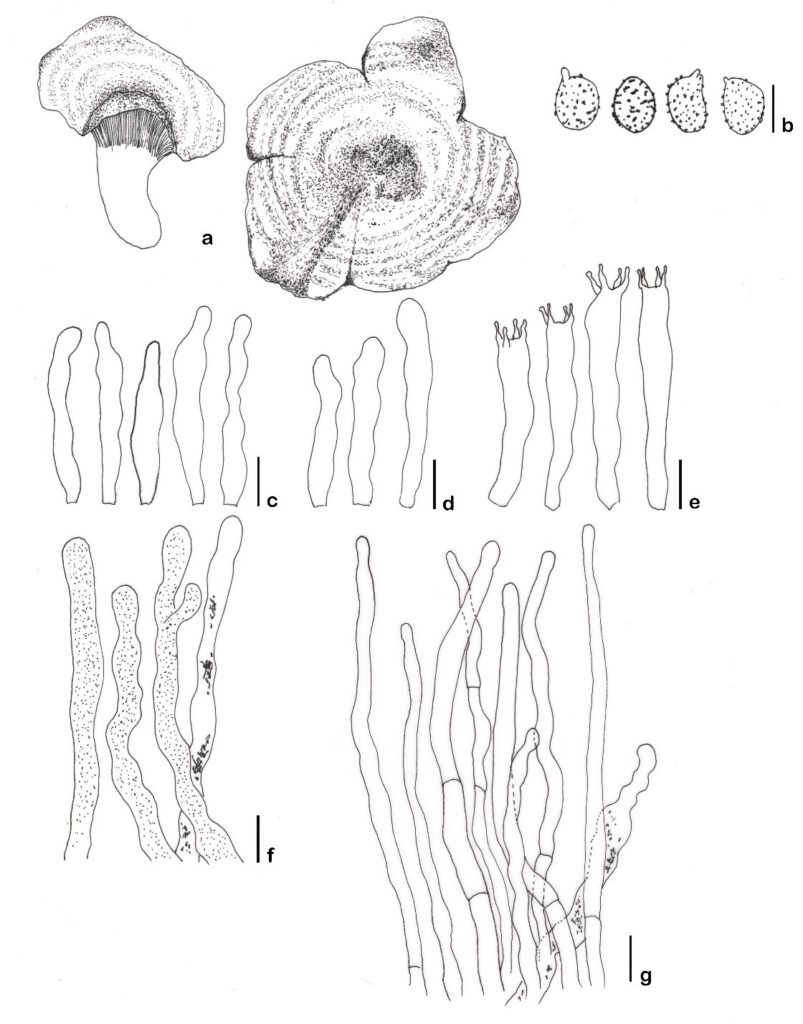Fungalpedia – Note 134 Multifurca
Multifurca Buyck & V. Hofst.
Citation if using this entry: Bera et al. (in prep) Basidiomycota. Mycosphere
Index Fungorum, Facesoffungi, MycoBank, GenBank, Fig. 1
Basidiomycota, Agaricomycetes, Russulales, Russulaceae
The traditional concept of the family Russulaceae was revolutionized with the introduction of the multi-locus (nrITS, nrLSU, rpb2) phylogenetic analysis by Buyck et al. (2008). One of the major consequences of this was the erection of the genus Multifurca out of the two pre-existing agaricoid genera Lactarius Pers., and Russula Pers. to minimize the phylogenetic and nomenclatural disparity (Buyck et al. 2008, 2010). The strongly-supported monophyletic clade comprising members of Russula subsect. Ochricompactae Bills & O.K. Mill. and one species of Lactarius, L. furcatus Coker was accommodated under Multifurca (Buyck et al. 2008).
This genus is a “hybrid” of Russula and Lactarius as it contains both lactarioid and russuloid species (Buyck et al. 2008). The basidiomata of Multifurca are yellow to salmon with concentric zonations on the pileus (Buyck et al. 2008). The lamellae are regularly forked producing the darkest spore prints with unusually small-sized basidiospores (Buyck et al. 2008). The members of this genus have a typical citronella or resinaceous odor which is unique in the family Russulaceae (Buyck et al. 2008, 2010, Wang et al. 2018). Phylogenetically, Multifurca is the only genus of the family that is reminiscent of the earlier resupinate genera, Gloeocystidiellum Donk Donk and Boidinia Stalpers & Hjortstam (Buyck et al. 2008, Wang et al. 2018).
The ectomycorrhizal habitat of the genus is quite confounding primarily because no definitive evidence exists although all specimens documented so far have been gathered from the forest floors near potential host trees (Coker 1918, Bills & Miller 1984, Buyck & Desjardin 2003, Montoya et al. 2003, Buyck 2004, Buyck et al. 2008, Wang & Liu 2010, Lebel et al. 2013, Wang et al. 2018). One of the interesting features of Multifurca is its amphi-pacific distribution. The genus usually appears in subtropical to tropical forests of southern Asia, New Caledonia, southeastern USA, and Central America to date (Coker 1918, Montoya et al. 2003, Buyck et al. 2008, Wang & Liu 2010, Wang et al. 2018) but exceptionally, Multifurca stenophylla (Berk.) T. Lebel, C.W. Dunk & T.W. May has been identified in temperate and cool southern eucalyptus forests, as well as in Nothofagus rainforests in southeastern Australia and Tasmania (Lebel et al. 2013, Wang et al. 2018). So far, there have been a total of 12 recorded species of Multifurca listed in the Index Fungorum (http://www.indexfungorum.org).
Type species: Multifurca ochricompacta (Bills & O.K. Mill.) Buyck & V. Hofst.
Figure 1. Multifurca furcata. a. Basidiomata. b. Basidiospores. c. Marginal cells. d. Basidioles. e. Basidia. f. Pseudocystidia of the hymenium. g. Hyphal terminations of the pileipellis. Scale bar b = 5 μm, c-g = 10 μm. Drawn from Wang et al. 2018.
References
Bills GF, Miller Jr OK 1984 – Southern Appalachian Russulas. I. Mycologia, 76(6), 975–1002. https://www.tandfonline.com/doi/abs/10.1080/00275514.1984.12023944
Buyck B 2004 – Short diagnoses and descriptions for some exotic Russula (Basidiomycotina). Cryptogamie, Mycologie, 25(2), 127–128. https://www.researchgate.net/profile/Bart-Buyck/publication/275033674_Short_diagnoses_and_descriptions_for_some_exotic_Russula_Basidiomycotina/links/5e491e9fa6fdccd965a94c0a/Short-diagnoses-and-descriptions-for-some-exotic-Russula-Basidiomycotina.pdf
Buyck B, Desjardin DE 2003 – Russula zonaria, a new species of Russula subsect. Ochricompactae from Thailand. Cryptogamie Mycologie, 24(2), 111–116. https://d1wqtxts1xzle7.cloudfront.net/48289480/Russula_zonaria_a_new_species_of_Russula20160824-321-1vlk5nf-libre.pdf?1472066671=&response-content-disposition=inline%3B+filename%3DRussula_zonaria_a_new_species_of_Russula.pdf&Expires=1693377930&Signature=dr7metqhDP28h4JDfIruwx2zz6~3BWv2rhjuFTwwUXXq9sydFnKBevbCUdScT33zdlopLWoDYDH7oSfmTIFppdOLSeYCp7HPXt0BhvyIi4H0FNVDOeBPdDZn6bW~-MfIRAwhbmMnUWOgw5IJDHXMMoecevvfQ3j4OcdmevDOabL4VxLWD5xfWV40pcAuF3RYSFOfOQrJ4TTnMPhgQEzcb~Id7cnClw8mM24KOiibRzPT-NE1SkEkQGnfXmu6qA9fataAsCSXBDVuflyLoeNqcB7uaVW-ZNDebr-7LQ6nW6KHuNVFu3MjcfS12dMqIINFxalYvqxbddMmGVUljzlB3A__&Key-Pair-Id=APKAJLOHF5GGSLRBV4ZA
Buyck B, Hofstetter V, Eberhardt U, Verbeken A, Kauff F 2008 – Walking the thin line between Russula and Lactarius: the dilemma of Russula subsect. Ochricompactae. Fungal Diversity, 28, 15–40. https://www.fungaldiversity.org/fdp/sfdp/28-2.pdf
Buyck B, Hofstetter V, Verbeken A, Walleyn R 2010 – Proposal to conserve the name Lactarius (Basidiomycota) with a conserved type and to conserve Lactariopsis (Basidiomycota) against Lactifluus and Galorrheus. Taxon, 59(1), 1–12. https://biblio.ugent.be/publication/1249453
Coker WC 1918 – The Lactarius of North Carolina. J. Elisha Mitchell Sci. Soc., 34, 1–61.
Lebel T, Dunk CW, May TW 2013 – Rediscovery of Multifurca stenophylla (Berk.) T. Lebel, CW Dunk & TW May comb. nov. (Russulaceae) from Australia. Mycological Progress, 12(3), 497–504. https://link.springer.com/article/10.1007/s11557-012-0856-4
Montoya L, Bandala VM, Halling R 2003 – Lactarius furcatus in Mexico and Costa Rica. Mycotaxon, 87, 311–316. https://www.semanticscholar.org/paper/Lactarius-furcatus-in-Mexico-and-Costa-Rica-Montoya-Bandala/e37738f5666ce055e2e8d00ceff7029d89ed629a
Wang XH, Liu PG 2010 – Multifurca (Russulales), a genus new to China. Cryptogamie, M ycologie, 31(1), 9–16. https://sciencepress.mnhn.fr/sites/default/files/articles/pdf/cryptogamie-mycologie2010v31f1a2.pdf
Wang XH, Halling RE, Hofstetter V, Lebel T, Buyck B 2018 – Phylogeny, biogeography and taxonomic re-assessment of Multifurca (Russulaceae, Russulales) using three-locus data. Plos One, 13(11), e0205840. https://journals.plos.org/plosone/article?id=10.1371/journal.pone.0205840
Entry by
Ishika Bera, Center of Excellence in Fungal Research, Mae Fah Luang University, Chiang Rai 57100, Thailand
(Edited by Kevin D Hyde)
